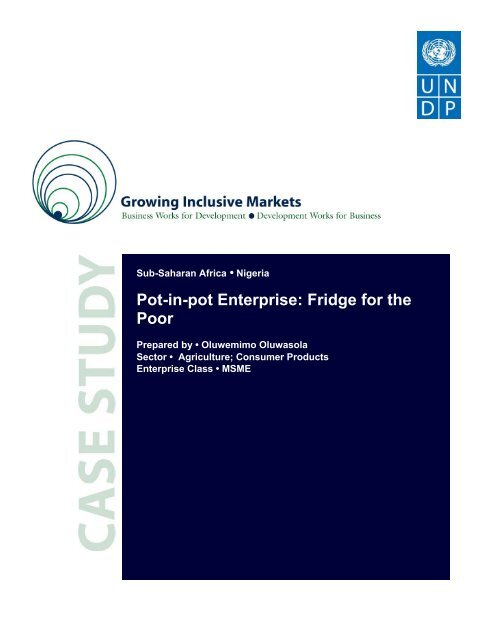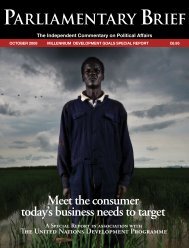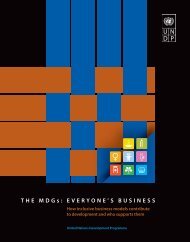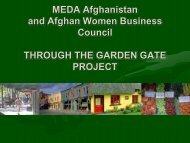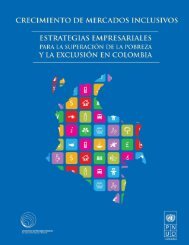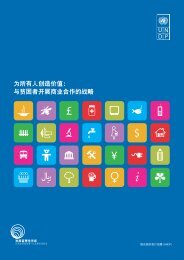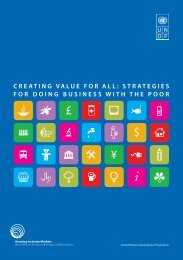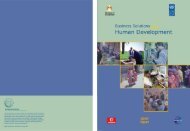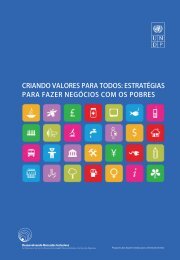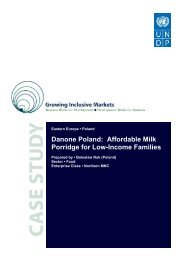Pot-in-pot Enterprise: Fridge for the Poor - Growing Inclusive Markets
Pot-in-pot Enterprise: Fridge for the Poor - Growing Inclusive Markets
Pot-in-pot Enterprise: Fridge for the Poor - Growing Inclusive Markets
You also want an ePaper? Increase the reach of your titles
YUMPU automatically turns print PDFs into web optimized ePapers that Google loves.
Sub-Saharan Africa • Nigeria<strong>Pot</strong>-<strong>in</strong>-<strong>pot</strong> <strong>Enterprise</strong>: <strong>Fridge</strong> <strong>for</strong> <strong>the</strong><strong>Poor</strong>Prepared by • Oluwemimo OluwasolaSector • Agriculture; Consumer Products<strong>Enterprise</strong> Class • MSME
Executive SummaryMobah Rural Horizons, producer of <strong>the</strong> <strong>pot</strong>-<strong>in</strong>-<strong>pot</strong> products which is widely termed as <strong>the</strong> ‘fridge<strong>for</strong> <strong>the</strong> poor’ is based <strong>in</strong> Kano, Nigeria. The organization was founded <strong>in</strong> 2000 by Mr. MallamMohammed Bah Abba. However, its ma<strong>in</strong> production centres are <strong>in</strong> <strong>the</strong> rural areas of Kano,Jigawa, Borno, Yobe and Kats<strong>in</strong>a States, all <strong>in</strong> <strong>the</strong> nor<strong>the</strong>rn region of Nigeria. The enterprise alsooperates <strong>in</strong> some parts of <strong>the</strong> Niger Republic. The region lies <strong>in</strong> <strong>the</strong> desert scrubland and is<strong>in</strong>habited ma<strong>in</strong>ly by poor subsistence farmers liv<strong>in</strong>g under <strong>the</strong> <strong>in</strong>fluence of fundamental Islamicculture. The poverty of <strong>the</strong> region is fur<strong>the</strong>r compounded by <strong>the</strong> fact that all <strong>the</strong> farmers producesimilar farm products which stifles exchange. The region lacks basic <strong>in</strong>frastructure like roads andelectricity which <strong>for</strong>ces farmers to sell <strong>the</strong>ir farm produce at cheap prices with substantial parts of<strong>the</strong>ir produce spoil<strong>in</strong>g be<strong>for</strong>e <strong>the</strong>y get <strong>in</strong>to <strong>the</strong> food distribution cha<strong>in</strong>. Clearly, a way out of <strong>the</strong>problem is provid<strong>in</strong>g access roads to l<strong>in</strong>k <strong>the</strong>m up with <strong>the</strong> urban markets or, provid<strong>in</strong>g electricityso that <strong>the</strong> farm products could be stored to prolong <strong>the</strong>ir shelf life.The <strong>pot</strong>-<strong>in</strong>-<strong>pot</strong> preservation/cool<strong>in</strong>g system was <strong>in</strong>vented ma<strong>in</strong>ly to help rural farmers preserve<strong>the</strong>ir farm products. The product was persistently ref<strong>in</strong>ed <strong>for</strong> two years between 1995 and 1997.Us<strong>in</strong>g personal sav<strong>in</strong>gs, Abba tapped <strong>in</strong>to <strong>the</strong> large, unemployed, local work<strong>for</strong>ce, and produced<strong>the</strong> first set of <strong>pot</strong>s number<strong>in</strong>g 12,000, which he distributed to farm<strong>in</strong>g households freely. Thiswas done to promote <strong>the</strong> appreciation of <strong>the</strong> product as well as stimulate local demand <strong>for</strong> it. In2000, he began full commercial production of <strong>the</strong> <strong>pot</strong>s us<strong>in</strong>g local <strong>pot</strong> makers with eachparticipant mak<strong>in</strong>g between 15 and 20 <strong>pot</strong>s a day. The <strong>pot</strong>s sold <strong>for</strong> between US$2 (N300) <strong>for</strong> <strong>the</strong>smaller <strong>pot</strong>-<strong>in</strong>-<strong>pot</strong> and US$4 (N600) <strong>for</strong> <strong>the</strong> bigger version. As of 2005, <strong>the</strong> <strong>in</strong>ventor haddelivered over 90,000 <strong>pot</strong>s and production has cont<strong>in</strong>ued to <strong>in</strong>crease.The ma<strong>in</strong> challenges faced by <strong>the</strong> project <strong>in</strong>clude: educat<strong>in</strong>g <strong>the</strong> villagers about this simpletechnology; gett<strong>in</strong>g <strong>the</strong> <strong>in</strong>itial funds to produce and distribute <strong>the</strong> product; <strong>the</strong> difficulties ofgett<strong>in</strong>g transportation to distribute <strong>the</strong> <strong>pot</strong>s, and educat<strong>in</strong>g <strong>the</strong> villagers to accept and purchase hisnew <strong>in</strong>vention. The <strong>in</strong>ventor received modest assistance from family members, UNDP, <strong>the</strong>M<strong>in</strong>istry of Women Affairs, and Jigawa State Polytechnic, and also received US$75,000 from <strong>the</strong>Rolex Award <strong>for</strong> <strong>Enterprise</strong>. The <strong>pot</strong>-<strong>in</strong>-<strong>pot</strong> enterprise has impacted positively rural farm<strong>in</strong>ghouseholds by provid<strong>in</strong>g employment, <strong>in</strong>creas<strong>in</strong>g farm earn<strong>in</strong>gs and enabl<strong>in</strong>g girl children toattend school <strong>in</strong> <strong>the</strong> morn<strong>in</strong>gs <strong>in</strong>stead of hawk<strong>in</strong>g perishable farm products.Case Study ● <strong>Pot</strong>-<strong>in</strong>-<strong>pot</strong> <strong>Enterprise</strong>: <strong>Fridge</strong> <strong>for</strong> <strong>the</strong> <strong>Poor</strong> 2
IntroductionThe <strong>pot</strong>-<strong>in</strong>-<strong>pot</strong> enterprise, designed to help improve <strong>the</strong> well-be<strong>in</strong>g of rural dwellers, wasconceived <strong>for</strong> <strong>the</strong> arid region of nor<strong>the</strong>rn Nigeria which lies ma<strong>in</strong>ly with<strong>in</strong> <strong>the</strong> grassland of <strong>the</strong>Sudan and Sahel Savannah vegetation belts. These regions are characterized largely by desertfeatures: hot days and high diurnal temperatures, low relative humidity and low ra<strong>in</strong>fall that isconcentrated with<strong>in</strong> three months. The area covers approximately 397,170 km 2 (43% of Nigeria’stotal land area). The vegetation is ma<strong>in</strong>ly desert scrubland. In terms of natural resourceoccurrence, <strong>the</strong> region is <strong>the</strong> least endowed <strong>in</strong> Nigeria. Incidentally, <strong>the</strong> region is home to about35.1% (49.1 million) of Nigeria’s 140 million people. 1 Dom<strong>in</strong>ated by <strong>the</strong> Islamic religion andculture, <strong>the</strong> <strong>in</strong>habitants of <strong>the</strong> region are also <strong>the</strong> least educated population <strong>in</strong> <strong>the</strong> country.In terms of occupation, <strong>the</strong> people are mostly subsistence farmers and cattle rearers. The shortcropp<strong>in</strong>g period of three months result<strong>in</strong>g from low ra<strong>in</strong>fall duration, implies that <strong>for</strong> n<strong>in</strong>emonths, <strong>the</strong> people have to depend on <strong>the</strong> farm produce planted dur<strong>in</strong>g those months and pastsav<strong>in</strong>gs (if any) to survive. Consequently, <strong>the</strong> capacity to store food products dur<strong>in</strong>g harvestperiod becomes very critical <strong>for</strong> household food security. The poverty of <strong>the</strong> region is fur<strong>the</strong>rcompounded by <strong>the</strong> fact that all <strong>the</strong> farmers produce similar farm products, which stiflesexchange and commerce. The region lacks good roads to l<strong>in</strong>k <strong>the</strong>m up with <strong>the</strong> few urban centreswhere <strong>the</strong>ir crops are needed. Where <strong>the</strong> roads exist, <strong>the</strong>y are <strong>in</strong> deplorable conditions. The ruralareas <strong>in</strong> this region also lack access to modern electricity supply. Consequently, farmers sell <strong>the</strong>irfarm produce at cheap prices, o<strong>the</strong>rwise <strong>the</strong> farm products will go rotten. When <strong>the</strong> crops rot, <strong>the</strong>stench and its implications also create serious health and environmental problems as flies <strong>in</strong>vade<strong>the</strong> house and <strong>the</strong> compounds become unsightly.Gett<strong>in</strong>g out of poverty is thus a major challenge whose solution was (and is still) far beyond <strong>the</strong>capacity of <strong>the</strong> rural dwellers. The simple solution to <strong>the</strong> problem of <strong>the</strong>se rural folks lies <strong>in</strong> ei<strong>the</strong>rprovid<strong>in</strong>g access roads to l<strong>in</strong>k <strong>the</strong>m up with <strong>the</strong> urban centres <strong>for</strong> <strong>the</strong>m to sell <strong>the</strong>ir farm produce,as well as open up <strong>the</strong> local economy to outside <strong>in</strong>vestors to create non-farm employment, or,provid<strong>in</strong>g electricity that will allow <strong>for</strong> opportunities <strong>for</strong> refrigeration so that <strong>the</strong> farm productscould be stored to prolong <strong>the</strong>ir shelf life. These two solutions lie <strong>in</strong> <strong>the</strong> purview of <strong>the</strong> State.Incidentally, <strong>in</strong> <strong>the</strong> last 49 years of <strong>in</strong>dependence, <strong>the</strong> size of <strong>the</strong> nation, <strong>the</strong> smallness 2 anddispersed nature of rural communities as well as dw<strong>in</strong>dl<strong>in</strong>g resources have been major factorsconstra<strong>in</strong><strong>in</strong>g <strong>the</strong> access of <strong>the</strong> region to <strong>the</strong> supply of social overheads, notably roads andelectricity.1 NPC (2006)2 Rural areas <strong>in</strong> Nigeria are small villages compris<strong>in</strong>g of few households with a population of less than 1,000<strong>in</strong> most cases. This makes it costly and difficult to access <strong>the</strong>m to roads, water and electric l<strong>in</strong>es.Case Study ● <strong>Pot</strong>-<strong>in</strong>-<strong>pot</strong> <strong>Enterprise</strong>: <strong>Fridge</strong> <strong>for</strong> <strong>the</strong> <strong>Poor</strong> 3
Mohammed Bah Abba with clients <strong>in</strong> a localmarket (Photo: from <strong>the</strong> collections ofMohammed Bah Abba)In Nigeria as <strong>in</strong> most develop<strong>in</strong>g nations, <strong>the</strong>problems of <strong>the</strong> rural poor such as described aboveare widespread and often do not engage <strong>the</strong>attention of <strong>the</strong> rul<strong>in</strong>g elite who concentrate ef<strong>for</strong>tsand resources <strong>in</strong> develop<strong>in</strong>g <strong>the</strong>ir capital and a fewo<strong>the</strong>r cities. The rural poor thus cont<strong>in</strong>ually battle<strong>the</strong> socio-economic and physical environment tosurvive. Yet, Mallam 3 Mohammed Bah Abba, aPolytechnic Lecturer <strong>in</strong> Bus<strong>in</strong>ess Management,was able to th<strong>in</strong>k through <strong>the</strong> problem of <strong>the</strong> ruralpoor and adapt a traditional storage device to<strong>in</strong>crease <strong>the</strong>ir quality of life; to get <strong>the</strong>ir farmproducts stored <strong>in</strong> a fridge that need no electricity,and save <strong>the</strong> girl child <strong>the</strong> trauma of trad<strong>in</strong>g school<strong>in</strong>g <strong>for</strong> hawk<strong>in</strong>g perishable farm products. In<strong>the</strong> words of Mr. Mohammed Bah Abba:“Although a well paid consultant with a permanent job as a Polytechnic lecturer,I saw <strong>the</strong> agony and helplessness of <strong>the</strong> people who produce what was notenough to susta<strong>in</strong> <strong>the</strong>m yet, lose <strong>the</strong>m as <strong>the</strong>y spoil. I discovered that <strong>the</strong>ir majorproblem was <strong>the</strong>ir <strong>in</strong>ability to store <strong>the</strong> crops (particularly <strong>the</strong> perishable ones)<strong>the</strong>y have produced which made <strong>the</strong>m to sell at give away prices to avoid <strong>the</strong>irspoil<strong>in</strong>g. I saw girls who ought to be <strong>in</strong> school hawk food and perishable farmproducts around communities. At times, when <strong>the</strong>y have nobody to buy <strong>the</strong>m, <strong>the</strong>yspoil and still have to live with <strong>the</strong> odour and <strong>the</strong> health effects. After muchagoniz<strong>in</strong>g, I thought of and found a way out to help <strong>the</strong>se people. My vision ofwhat I could do is <strong>the</strong> mission of Mobah Rural Horizons.”Mohammed Bah Abba took on <strong>the</strong> challenge of access<strong>in</strong>g <strong>the</strong> rural poor <strong>in</strong> <strong>the</strong> desert region witha simple technology that changed <strong>the</strong> socio-economic landscape of <strong>the</strong> rural areas of <strong>the</strong> lessendowed arid region of Nigeria, while creat<strong>in</strong>g an economically viable market <strong>for</strong> his <strong>in</strong>vention.Clearly, Abba has demonstrated <strong>the</strong> role of <strong>the</strong> private sector <strong>in</strong> foster<strong>in</strong>g economic developmentand how non-state actors can also contribute to achiev<strong>in</strong>g <strong>the</strong> Millennium Development Goals(MDGs) while seek<strong>in</strong>g to make some modest profit, especially <strong>in</strong> develop<strong>in</strong>g nations.When Abba f<strong>in</strong>ally came to terms with what to do to help <strong>the</strong> rural poor, he still had to th<strong>in</strong>kthrough a number of critical issues. How does he conv<strong>in</strong>ce people deeply attached to tradition toaccept his <strong>in</strong>vention? Did he have to manufacture <strong>the</strong> product or use <strong>the</strong> exist<strong>in</strong>g channels? Howdoes he get <strong>the</strong> product to <strong>the</strong> beneficiaries and at m<strong>in</strong>imum cost? Who pays <strong>for</strong> his time andef<strong>for</strong>ts? Alone, Abba had to provide answers to <strong>the</strong>se hard questions.3 Mallam is a title used <strong>for</strong> Islamic Scholars but which has been commonly adopted as “Mr.” <strong>in</strong> Nor<strong>the</strong>rnNigeria.Case Study ● <strong>Pot</strong>-<strong>in</strong>-<strong>pot</strong> <strong>Enterprise</strong>: <strong>Fridge</strong> <strong>for</strong> <strong>the</strong> <strong>Poor</strong> 4
Market and Location ContextThe adm<strong>in</strong>istrative headquarters of Mobah Rural Horizons, producer of <strong>the</strong> <strong>pot</strong>-<strong>in</strong>-<strong>pot</strong> productswhich is widely termed as <strong>the</strong> ‘fridge <strong>for</strong> <strong>the</strong> poor’ or ‘desert refrigerators’ is based <strong>in</strong> Kano, acity that is favourably endowed with modern development dividends like electricity, <strong>pot</strong>ablewater, non-farm employment opportunities and fairly good roads. However, its ma<strong>in</strong> productioncentres are <strong>in</strong> <strong>the</strong> rural areas of Kano, Jigawa, Borno, Yobe, Sokoto, Zamfara, Kebbi and Kats<strong>in</strong>aStates, all <strong>in</strong> <strong>the</strong> nor<strong>the</strong>rn region of Nigeria. The enterprise also operates <strong>in</strong> some parts of NigerRepublic. In terms of physical, environmental, development <strong>in</strong>dices and cultural background, <strong>the</strong>region is literally homogenous.PHYSICAL AND ENVIRONMENT CHARACTERISTICS OF THE REGIONThe region orig<strong>in</strong>ally lay <strong>in</strong> <strong>the</strong> Sudan Savannah belt, a vegetative belt where luscious grassesgrew. The Sudan supports <strong>in</strong>tensive farm<strong>in</strong>g and is home to <strong>the</strong> cultivation of cereals, yam,groundnut and beans. It also provides pasture <strong>for</strong> livestock farm<strong>in</strong>g. However, decades of humanactivities have degraded <strong>the</strong> environment and caused <strong>the</strong> Sahel Savannah, <strong>the</strong> vegetation beltbetween <strong>the</strong> Sahara Desert and <strong>the</strong> Sudan, to encroach on most parts of <strong>the</strong> Sudan Savannah. Infact, desert encroachment has affected most parts of <strong>the</strong> nor<strong>the</strong>rn fr<strong>in</strong>ges of <strong>the</strong>se States. Anannual ra<strong>in</strong>fall of between 100 to 300 mm which lasts <strong>for</strong> three months (mid-June to mid-September) occurs <strong>in</strong> <strong>the</strong> region, although <strong>in</strong> <strong>the</strong> Niger Republic, ra<strong>in</strong>fall may be <strong>in</strong>frequent anddrought is a constant phenomenon. Temperatures are also high (average of 35 0 C). These areas arethus very arid. The short ra<strong>in</strong>y season supports subsistence agriculture especially <strong>the</strong> cultivationof cereals, vegetables and animal husbandry.Development Indices of <strong>the</strong> RegionNor<strong>the</strong>rn Nigeria is a very large area. While this provides <strong>the</strong> space and land to use <strong>for</strong> <strong>the</strong> goodof <strong>the</strong> people, <strong>the</strong> sheer size of <strong>the</strong> region has proved to be a major constra<strong>in</strong>t to development.Development is thus concentrated ma<strong>in</strong>ly <strong>in</strong> <strong>the</strong> capital cities of <strong>the</strong> states <strong>in</strong> <strong>the</strong> region leav<strong>in</strong>g<strong>the</strong> rural areas where most of <strong>the</strong> people reside with very little to no <strong>in</strong>frastructures. Thedeprivation of <strong>the</strong> nor<strong>the</strong>rn region stems from colonial economic development policy, whichconcentrated development ef<strong>for</strong>ts on regions that produced exportable farm products. Almost all<strong>the</strong> states <strong>in</strong> nor<strong>the</strong>rn Nigeria are categorized as <strong>the</strong> least developed of <strong>the</strong> 36 States <strong>in</strong> <strong>the</strong> countryand <strong>the</strong>re<strong>for</strong>e have <strong>the</strong> least access to <strong>the</strong> dividends of economic development. 4Most of <strong>the</strong> people live <strong>in</strong> rural areas. In Sokoto, Kebbi, Jigawa, Yobe and Bauchi States, morethan 75% of <strong>the</strong> population is rural, while <strong>in</strong> Kano, Kats<strong>in</strong>a and Borno States, up to 65% of <strong>the</strong>population is rural. These rural areas lack basic <strong>in</strong>frastructure like roads, electricity, schools and4 Abumere (1998)Case Study ● <strong>Pot</strong>-<strong>in</strong>-<strong>pot</strong> <strong>Enterprise</strong>: <strong>Fridge</strong> <strong>for</strong> <strong>the</strong> <strong>Poor</strong> 5
subsistent farm<strong>in</strong>g households suffered greatly <strong>in</strong> produc<strong>in</strong>g crops <strong>in</strong> <strong>the</strong> harsh desertenvironment, which <strong>the</strong>y ended los<strong>in</strong>g to post-harvest losses or sold very cheaply, <strong>the</strong>rebyexacerbat<strong>in</strong>g <strong>the</strong> problem of poverty associated with <strong>the</strong> farmers and <strong>the</strong> rural areas. It was thisstate of <strong>the</strong> rural communities that set Mohammed Abba th<strong>in</strong>k<strong>in</strong>g; <strong>in</strong> his words:“It was sadden<strong>in</strong>g to see <strong>the</strong> fear and hopelessness on <strong>the</strong> faces of women whohave to throw away decayed food products. They know soon, when <strong>the</strong>y havenoth<strong>in</strong>g to serve <strong>the</strong>ir families, <strong>the</strong>y will remember what <strong>the</strong>y threw away. It wasalso bad watch<strong>in</strong>g small girls hawk around villages <strong>in</strong>stead of go<strong>in</strong>g to school. Itwas bad to know that <strong>the</strong> two th<strong>in</strong>gs keep<strong>in</strong>g <strong>the</strong> people perpetually poor werelack of access roads to l<strong>in</strong>k <strong>the</strong>m with <strong>the</strong> cities and lack of electricity. Thispassion <strong>for</strong> <strong>the</strong> poor was <strong>the</strong> reason I thought of this project.”INNOVATING AN AGE-OLD TECHNOLOGYThe solution Mallam Abba found after much agoniz<strong>in</strong>g was rooted <strong>in</strong> his family background.Born <strong>in</strong> 1964 <strong>in</strong>to a family of <strong>pot</strong> makers and raised <strong>in</strong> <strong>the</strong> rural north, Mohammed Bah Abba wasfamiliar from an early age with <strong>the</strong> s<strong>in</strong>gle unit clay <strong>pot</strong> as well as <strong>the</strong> various practical andsymbolic uses of traditional clay <strong>pot</strong>s. He also learned as a child <strong>the</strong> rudiments of <strong>pot</strong>tery mak<strong>in</strong>g.Armed with a University education <strong>in</strong> management sciences and <strong>the</strong> knowledge of <strong>the</strong> roletraditional clay <strong>pot</strong>s could play <strong>in</strong> <strong>the</strong> farm<strong>in</strong>g economy, he set out to scale-up <strong>the</strong> s<strong>in</strong>gle -unit<strong>pot</strong>s he grew up with <strong>in</strong> rural areas, <strong>in</strong>to <strong>the</strong> double unit termed <strong>the</strong> ‘<strong>pot</strong>-<strong>in</strong>-<strong>pot</strong>preservation/cool<strong>in</strong>g system.’ 11Typical <strong>Pot</strong>-<strong>in</strong> <strong>Pot</strong> Ready (Photo: from<strong>the</strong> collections of Muhammed BahAbba)The <strong>pot</strong>-<strong>in</strong>-<strong>pot</strong> technology consists of two ear<strong>the</strong>nware<strong>pot</strong>s of different diameters, one placed <strong>in</strong>side <strong>the</strong> o<strong>the</strong>r.The space between <strong>the</strong> two <strong>pot</strong>s is filled with wet sandthat is kept constantly moist, <strong>the</strong>reby keep<strong>in</strong>g both <strong>pot</strong>sdamp. Fruit, vegetables and o<strong>the</strong>r items such as softdr<strong>in</strong>ks are put <strong>in</strong> <strong>the</strong> smaller <strong>in</strong>ner <strong>pot</strong>, which is coveredwith a damp cloth. The phenomenon that occurs is basedon a simple pr<strong>in</strong>ciple of physics: <strong>the</strong> water conta<strong>in</strong>ed <strong>in</strong><strong>the</strong> sand between <strong>the</strong> two <strong>pot</strong>s evaporates towards <strong>the</strong>outer surface of <strong>the</strong> larger <strong>pot</strong> where <strong>the</strong> drier outside airis circulat<strong>in</strong>g. By virtue of <strong>the</strong> laws of <strong>the</strong>rmodynamics,<strong>the</strong> evaporation process automatically causes a drop <strong>in</strong>temperature of several degrees, cool<strong>in</strong>g <strong>the</strong> <strong>in</strong>nerconta<strong>in</strong>er, destroy<strong>in</strong>g harmful micro-organisms andpreserv<strong>in</strong>g <strong>the</strong> perishable foods <strong>in</strong>side.11 The <strong>pot</strong> mak<strong>in</strong>g bus<strong>in</strong>ess has existed from time immemorial; however, <strong>the</strong> idea of putt<strong>in</strong>g a <strong>pot</strong> <strong>in</strong> a <strong>pot</strong>was a novel one. Mohammed Bah Abba holds no patent on this <strong>in</strong>vention and has no control over what isdone with his idea, at least among <strong>the</strong> o<strong>the</strong>r <strong>pot</strong> maters <strong>in</strong> Nigeria.Case Study ● <strong>Pot</strong>-<strong>in</strong>-<strong>pot</strong> <strong>Enterprise</strong>: <strong>Fridge</strong> <strong>for</strong> <strong>the</strong> <strong>Poor</strong> 7
Accord<strong>in</strong>g to <strong>the</strong> Rolex Awards <strong>for</strong> <strong>Enterprise</strong> (2005), Abba’s first trials of <strong>the</strong> <strong>pot</strong>-<strong>in</strong>-<strong>pot</strong> provedsuccessful. Eggplants, <strong>for</strong> example, stayed fresh <strong>for</strong> 27 days <strong>in</strong>stead of three, while guavas,tomatoes and peppers lasted <strong>for</strong> three weeks or more <strong>in</strong>stead of two to three days. Africansp<strong>in</strong>ach, which usually spoils after a day, rema<strong>in</strong>ed edible after 12 days <strong>in</strong> <strong>the</strong> <strong>pot</strong>-<strong>in</strong>-<strong>pot</strong>. Between1995 and 1997, <strong>the</strong> <strong>in</strong>vention was persistently ref<strong>in</strong>ed to get <strong>the</strong> best fit of <strong>the</strong> bigger outer <strong>pot</strong>and <strong>the</strong> smaller <strong>in</strong>ner <strong>pot</strong> that would be stable and durable. Abba’s <strong>pot</strong> <strong>in</strong> <strong>pot</strong> was markedlydifferent from <strong>the</strong> traditional <strong>pot</strong>s <strong>in</strong> that <strong>the</strong>re were two <strong>pot</strong>s <strong>in</strong> one. He also used farm wastes toburn <strong>the</strong> clay <strong>pot</strong>s to make it glossy and stronger. Armed with <strong>the</strong> required specification, Abbatapped <strong>in</strong>to <strong>the</strong> large unemployed local work<strong>for</strong>ce and hired skilled <strong>pot</strong> makers to mass produce<strong>the</strong> first batch of 5,000 <strong>pot</strong>-<strong>in</strong>-<strong>pot</strong>s. Manufactur<strong>in</strong>g <strong>the</strong>se devices at his own expense, he begandistribut<strong>in</strong>g <strong>the</strong>m <strong>for</strong> free to five villages <strong>in</strong> Jigawa State to create awareness of this new product.As well as creat<strong>in</strong>g a local demand <strong>for</strong> it after demonstrat<strong>in</strong>g its usefulness <strong>for</strong> food crop storage.In 1999, Abba supplied ano<strong>the</strong>r dozen local villages with 7,000 <strong>pot</strong>s, aga<strong>in</strong> at his own expense.For this <strong>in</strong>itial phase of his project, he received modest f<strong>in</strong>ancial back<strong>in</strong>g from family sources andassistance <strong>in</strong> <strong>the</strong> <strong>for</strong>m of transportation, fuel and labour from <strong>the</strong> UNDP, a local women’sdevelopment group and <strong>the</strong> Jigawa State Polytechnic. When <strong>the</strong> rural communities <strong>in</strong> <strong>the</strong> JigawaState had sufficiently understood <strong>the</strong> work<strong>in</strong>gs of <strong>the</strong> <strong>pot</strong>-<strong>in</strong>-<strong>pot</strong> technology, and <strong>the</strong> people begandemand<strong>in</strong>g <strong>the</strong> product, <strong>the</strong> <strong>in</strong>ventor embarked on its commercial production and distribution ataf<strong>for</strong>dable costs.PRODUCTION AND DISTRIBUTION SYSTEMSThe mak<strong>in</strong>g and market<strong>in</strong>g of <strong>the</strong> <strong>pot</strong>-<strong>in</strong>-<strong>pot</strong> takes a most <strong>in</strong>genious method. Mohammed BahAbba has no factory or workshop where he makes <strong>the</strong> <strong>pot</strong>. The bus<strong>in</strong>ess is not registered with <strong>the</strong>Corporate Affairs Commission as it operates like a local <strong>in</strong><strong>for</strong>mal outfit. In each community Abbatries to sell his products, he identifies <strong>the</strong> local <strong>pot</strong> makers and commissions <strong>the</strong>m to make <strong>the</strong><strong>pot</strong>s to his own specification. He <strong>the</strong>n pays <strong>the</strong>m on <strong>the</strong> successful completion of <strong>the</strong> <strong>pot</strong>s, andsells <strong>the</strong>m <strong>in</strong> <strong>the</strong> market place. The procedure from production to market<strong>in</strong>g takes <strong>the</strong> follow<strong>in</strong>g,simple process.Typical <strong>Pot</strong>-<strong>in</strong> <strong>Pot</strong> Ready <strong>for</strong> sale (Photo:Mohamed Majzoub)First, <strong>the</strong> <strong>in</strong>ventor identifies a community where hefeels he wants to <strong>in</strong>troduce <strong>the</strong> <strong>pot</strong>. The criteria <strong>for</strong>selection were based first on demand and also on <strong>the</strong>availability of local resources <strong>in</strong> terms of clay andskilled hands <strong>in</strong> <strong>pot</strong>tery mak<strong>in</strong>g. The second step isvisit<strong>in</strong>g <strong>the</strong> community, and mobiliz<strong>in</strong>g <strong>the</strong> local<strong>pot</strong>tery makers, who have <strong>the</strong>ir own sheds, typical ofsmall scale <strong>in</strong><strong>for</strong>mal enterprise, <strong>in</strong> and around <strong>the</strong>area; show<strong>in</strong>g <strong>the</strong>m <strong>the</strong> required specifications of <strong>the</strong><strong>pot</strong>s and commission<strong>in</strong>g <strong>the</strong>m to produce <strong>the</strong> <strong>pot</strong>s.When <strong>the</strong> <strong>pot</strong>s have been produced, he has <strong>the</strong>m burntCase Study ● <strong>Pot</strong>-<strong>in</strong>-<strong>pot</strong> <strong>Enterprise</strong>: <strong>Fridge</strong> <strong>for</strong> <strong>the</strong> <strong>Poor</strong> 8
us<strong>in</strong>g farm residue to <strong>in</strong>crease <strong>the</strong>ir strength and durability. Accord<strong>in</strong>g to Abba:“Fortunately, clay <strong>in</strong> Nigeria is ubiquitous and is a free resource. The identified<strong>pot</strong> makers are asked to make <strong>the</strong> <strong>pot</strong> accord<strong>in</strong>g to specification. The <strong>pot</strong>s are<strong>the</strong>n burnt to make <strong>the</strong>m stronger us<strong>in</strong>g hay and dried grass. The f<strong>in</strong>ishedproduct is <strong>the</strong>n taken to <strong>the</strong> market and sold directly to <strong>in</strong>dividual consumers orto retailers who sell to <strong>the</strong> people.”Each <strong>pot</strong> maker could make between 15 and 20 <strong>pot</strong>s <strong>in</strong> a day. The <strong>pot</strong>s sell <strong>for</strong> between US$2(N300) <strong>for</strong> <strong>the</strong> smaller <strong>pot</strong>-<strong>in</strong>-<strong>pot</strong> and US$4 (N600) <strong>for</strong> <strong>the</strong> bigger version. When <strong>the</strong> <strong>pot</strong>s are soldto retailers who normally buy <strong>in</strong> bulk, <strong>the</strong> prices are reduced so <strong>the</strong>y can sell at <strong>the</strong> market rateand make <strong>the</strong> necessary marg<strong>in</strong> to stay <strong>in</strong> bus<strong>in</strong>ess. Abba has no scientific means of determ<strong>in</strong><strong>in</strong>g<strong>the</strong> level of demand <strong>in</strong> a particular market. Typical of <strong>in</strong><strong>for</strong>mal sector operators, Abba’s marketprojections are based on <strong>in</strong>tuition and knowledge of <strong>the</strong> people and <strong>the</strong>ir activities. Sometimes,<strong>the</strong> <strong>pot</strong>s are cleared <strong>in</strong> <strong>the</strong> market while at o<strong>the</strong>r times, <strong>the</strong>re will be leftovers. <strong>Pot</strong>s that rema<strong>in</strong>unsold <strong>in</strong> a particular market are transported by buses or ox-drawn carts to markets <strong>in</strong> o<strong>the</strong>rcommunities where <strong>the</strong>y are <strong>the</strong>n sold. Until such unsold wares are disposed, new productiontemporarily stops. S<strong>in</strong>ce Abba’s markets are small, it does not take much time be<strong>for</strong>e <strong>the</strong>y arebought by new patrons or by old <strong>pot</strong> users who want to replace broken <strong>pot</strong>s.In addition to Abba’s <strong>in</strong>genious market<strong>in</strong>g system, <strong>the</strong> sales of <strong>the</strong> <strong>pot</strong>-<strong>in</strong>-<strong>pot</strong> products alsobenefitted from poverty reduction programmes of state governments as <strong>the</strong> state’s M<strong>in</strong>istry ofWomen Affairs <strong>in</strong> <strong>the</strong> nor<strong>the</strong>rn region bought <strong>in</strong>to <strong>the</strong> project and purchased <strong>the</strong> <strong>pot</strong>s <strong>for</strong>distribution to its women beneficiaries <strong>in</strong> <strong>the</strong> rural areas. Such women used <strong>the</strong> <strong>pot</strong>-<strong>in</strong>-<strong>pot</strong> to storeprepared local food stuffs, soft dr<strong>in</strong>ks and water <strong>for</strong> domestic uses <strong>the</strong>reby promot<strong>in</strong>g non-farmand women-targeted employment activities.CONSTRAINTS AND SOLUTIONSThe <strong>in</strong>vention, distribution and acceptance of <strong>the</strong> <strong>pot</strong>-<strong>in</strong>-<strong>pot</strong> faced a number of challenges, which<strong>the</strong> <strong>in</strong>ventor carefully surmounted with his personal will-power and modest assistance fromo<strong>the</strong>rs. One such obstacle, and perhaps <strong>the</strong> most important, was educat<strong>in</strong>g <strong>the</strong> villagers about thissimple technology and mak<strong>in</strong>g <strong>the</strong>m accept its usage. To overcome this challenge, Abba devisedan educational campaign tailored to village life and <strong>the</strong> illiterate population, featur<strong>in</strong>g a videorecordedplay by local actors who dramatize <strong>the</strong> benefits of <strong>the</strong> desert refrigerator. While days arefilled with work on <strong>the</strong> farms, night life <strong>in</strong> a rural community without electricity is usually dulland brief. After secur<strong>in</strong>g <strong>the</strong> very crucial support of <strong>the</strong> community leader(s) <strong>for</strong> his products,Abba hired local drummers to play around <strong>the</strong> villages to send signals to <strong>the</strong> people thatsometh<strong>in</strong>g was go<strong>in</strong>g to happen at <strong>the</strong> village square shortly after <strong>the</strong> people return from <strong>the</strong>irfarms. In <strong>the</strong> even<strong>in</strong>gs when <strong>the</strong> farmers will be most will<strong>in</strong>g to watch an enterta<strong>in</strong><strong>in</strong>gpresentation, <strong>the</strong> video presentation prepared by Abba is shown us<strong>in</strong>g a makeshift cloth screenand a portable projector and generator. The success of <strong>the</strong> even<strong>in</strong>g’s presentation determ<strong>in</strong>es <strong>the</strong>Case Study ● <strong>Pot</strong>-<strong>in</strong>-<strong>pot</strong> <strong>Enterprise</strong>: <strong>Fridge</strong> <strong>for</strong> <strong>the</strong> <strong>Poor</strong> 9
quantity of products Abba will have to produce <strong>for</strong> this specific market. S<strong>in</strong>ce <strong>the</strong> wideacceptability of <strong>the</strong> <strong>pot</strong>-<strong>in</strong>-<strong>pot</strong> technology, <strong>the</strong> activities of such drummers <strong>for</strong>m part of <strong>the</strong>communities’ mobilization process. To <strong>the</strong> people who lack <strong>the</strong> basic essentials <strong>for</strong> liv<strong>in</strong>g, <strong>the</strong><strong>pot</strong>-<strong>in</strong>-<strong>pot</strong> is a sign of ‘progress.’Ano<strong>the</strong>r challenge <strong>in</strong>cludes gett<strong>in</strong>g <strong>the</strong> <strong>in</strong>itial funds to produce and distribute <strong>the</strong> product. Abbahad to use his own personal sav<strong>in</strong>gs and some f<strong>in</strong>ancial assistance from family members toovercome this challenge. The last challenge was <strong>the</strong> difficulty of gett<strong>in</strong>g transportation todistribute <strong>the</strong> <strong>pot</strong>s and educat<strong>in</strong>g <strong>the</strong> villagers to accept and purchase this new <strong>in</strong>vention. TheUNDP office <strong>in</strong> <strong>the</strong> state and <strong>the</strong> M<strong>in</strong>istry of Women Affairs also provided modest assistance <strong>in</strong>this regard. The poor beneficiaries of <strong>the</strong> <strong>in</strong>vention also provided support. Abba said:“The roads to <strong>the</strong> rural areas are very deplorable. Even <strong>the</strong> houses <strong>the</strong>y live <strong>in</strong>have noth<strong>in</strong>g to write home about. However, <strong>the</strong> rural dwellers provided veryappreciable help. Sometimes, <strong>the</strong>y transport us with <strong>the</strong>ir donkeys withoutcharg<strong>in</strong>g a fee. They also give us free accommodation and food when we need topass <strong>the</strong> night <strong>in</strong> <strong>the</strong> villages. This <strong>in</strong> itself is a major source of encouragementthat lives are be<strong>in</strong>g touched. ”THE POT-IN-POT AND THE ENVIRONMENTA major concern about <strong>the</strong> operations of <strong>the</strong> bus<strong>in</strong>ess was <strong>the</strong> susta<strong>in</strong>ability of <strong>the</strong> environment.The m<strong>in</strong><strong>in</strong>g of <strong>the</strong> clay is not planned and is carried out by illiterate <strong>in</strong><strong>for</strong>mal operators who arenot licensed by governmental authorities. The second area of concern has to do with <strong>the</strong>application of fire to <strong>the</strong> molded <strong>pot</strong> <strong>in</strong> order to stabilize it. However, Mohammed Bah Abbadisagreed with any negative implications. Accord<strong>in</strong>g to him:“Clay occurs everywhere and <strong>the</strong> way <strong>the</strong>y are m<strong>in</strong>ed and <strong>the</strong> quantity extractedcannot cause any large scale damage to <strong>the</strong> environment. In any case, <strong>the</strong> peoplehave been m<strong>in</strong><strong>in</strong>g <strong>the</strong> resource long be<strong>for</strong>e I <strong>in</strong>troduced my <strong>pot</strong> and long after Ihave stopped do<strong>in</strong>g m<strong>in</strong>e, <strong>the</strong>y will still cont<strong>in</strong>ue to m<strong>in</strong>e it. Which is best?Leav<strong>in</strong>g <strong>the</strong> clay as it is or solv<strong>in</strong>g <strong>the</strong> endemic poverty <strong>in</strong> <strong>the</strong> region? I th<strong>in</strong>k <strong>the</strong>people come first. We also do not de<strong>for</strong>est. What we use <strong>in</strong> burn<strong>in</strong>g <strong>the</strong> completed<strong>pot</strong>s is <strong>the</strong> plant residue that is already dry. If <strong>the</strong>y are not used, <strong>the</strong> farmers willlater set fire on <strong>the</strong>m when prepar<strong>in</strong>g <strong>the</strong>ir farms. So, it is a question of f<strong>in</strong>d<strong>in</strong>ggood use <strong>for</strong> a bad problem.”The clay <strong>pot</strong> is however brittle and when handled roughly breaks easily. When <strong>the</strong>y break, <strong>the</strong>yare also useful <strong>in</strong> <strong>the</strong> household as <strong>the</strong>y can be used <strong>in</strong> <strong>the</strong> fireplace as stands <strong>for</strong> cook<strong>in</strong>g <strong>pot</strong>s or<strong>the</strong>y can be broken down and returned to soil.Case Study ● <strong>Pot</strong>-<strong>in</strong>-<strong>pot</strong> <strong>Enterprise</strong>: <strong>Fridge</strong> <strong>for</strong> <strong>the</strong> <strong>Poor</strong> 10
The Bus<strong>in</strong>ess and its RelationshipsThe ma<strong>in</strong> <strong>in</strong>ventor was Mr. Mohammed Bah Abba. The assistance he received was very modest,and <strong>the</strong> major actors who supported his <strong>in</strong>itiative were members of his own family. His olderbro<strong>the</strong>r provided modest f<strong>in</strong>ancial assistance <strong>for</strong> him to make and distribute <strong>the</strong> <strong>pot</strong>s. Hisgrandmo<strong>the</strong>r also re-tra<strong>in</strong>ed him <strong>in</strong> <strong>pot</strong>tery mak<strong>in</strong>g. The UNDP office <strong>in</strong> <strong>the</strong> state also provided avehicle <strong>for</strong> him to distribute his wares to <strong>the</strong> rural areas. The vehicle was fuelled by <strong>the</strong> M<strong>in</strong>istryof Women’s Affairs. Accord<strong>in</strong>g to Abba, this support lasted <strong>for</strong> only three months. The JigawaState Polytechnic also provided support by keep<strong>in</strong>g him on his job as a lecturer, while <strong>the</strong><strong>in</strong>ventor concentrated on mak<strong>in</strong>g and ref<strong>in</strong><strong>in</strong>g <strong>the</strong> <strong>pot</strong>s. The rural households who benefitted from<strong>the</strong> end product also provided assistance <strong>in</strong> terms of free transportation on donkeys <strong>in</strong> areas where<strong>the</strong> roads are bad and where vehicles could not ply, <strong>in</strong> addition to accommodation and feed<strong>in</strong>gwhere Abba and his assistants could sleep as <strong>the</strong>re are no hotels <strong>in</strong> <strong>the</strong> villages.Mohammed Abba also hired assistants namely, Muhammed Farah, Adulahi Jamiu and five o<strong>the</strong>rswho worked with him. These assistants were ma<strong>in</strong>ly male as <strong>the</strong> it<strong>in</strong>erant nature of <strong>the</strong> enterprisecoupled with <strong>the</strong> cultural sett<strong>in</strong>g would not permit a woman to follow men who move from onevillage to <strong>the</strong> o<strong>the</strong>r and hike and sleep here and <strong>the</strong>re. These assistants have been tra<strong>in</strong>ed by Abbaand <strong>the</strong>y follow him to <strong>the</strong> villages <strong>in</strong> his attempt to sell <strong>the</strong> <strong>pot</strong>-<strong>in</strong>-<strong>pot</strong> to his clients. Whendemand <strong>for</strong> <strong>the</strong> products overlap villages, Abba assigns <strong>the</strong>se assistants to different locationswhile he coord<strong>in</strong>ates <strong>the</strong> activities. This also allows him to attend to his lectures <strong>in</strong> <strong>the</strong>Polytechnic. Abba pays his assistants from <strong>the</strong> profits made from <strong>the</strong> sale of <strong>the</strong> <strong>pot</strong>s.In 2001, UNDP Nigeria nom<strong>in</strong>ated Abba’s project <strong>for</strong> <strong>the</strong> Rolex Award <strong>for</strong> <strong>Enterprise</strong>. The RolexAward <strong>for</strong> <strong>Enterprise</strong> provided <strong>the</strong> highest f<strong>in</strong>ancial assistance <strong>in</strong> 2001 through an award ofUS$75,000. With <strong>the</strong> award from Rolex, Abba got <strong>the</strong> f<strong>in</strong>ancial life-l<strong>in</strong>e he needed and was ableto produce and distribute <strong>pot</strong>-<strong>in</strong>-<strong>pot</strong>s <strong>in</strong> 11 nor<strong>the</strong>rn Nigerian states, and fur<strong>the</strong>r his plans <strong>for</strong> hisproducts <strong>in</strong> o<strong>the</strong>r countries such as Cameroon, Niger, Chad and <strong>the</strong> Democratic Republic ofCongo. In 2002, <strong>the</strong> Intermediate Technology Development Group (ITDG) and <strong>the</strong> University ofAl Fashir carried out experiments <strong>in</strong> Sudan to assess <strong>the</strong> per<strong>for</strong>mances of <strong>the</strong> <strong>pot</strong>-<strong>in</strong>-<strong>pot</strong> <strong>in</strong> foodconservation 12 after <strong>the</strong> Rolex Award was published. The excellent results led <strong>the</strong> Women’sAssociation <strong>for</strong> Ear<strong>the</strong>nware Manufactur<strong>in</strong>g <strong>in</strong> Darfur to manufacture <strong>the</strong>ir own <strong>pot</strong>-<strong>in</strong>-<strong>pot</strong>s,called zeer <strong>in</strong> Arabic.The simplicity of <strong>the</strong> technology, availability of raw clay, and <strong>the</strong> fact that <strong>the</strong>re exist skilful<strong>pot</strong>tery makers <strong>in</strong> <strong>the</strong> region, cancels out <strong>the</strong> challenge of competition. However, this does notbo<strong>the</strong>r Abba. In his words:12 ITDG Report can be found <strong>in</strong> www.rolexawards.com/media/images/common,banner-green-repeater.jpgCase Study ● <strong>Pot</strong>-<strong>in</strong>-<strong>pot</strong> <strong>Enterprise</strong>: <strong>Fridge</strong> <strong>for</strong> <strong>the</strong> <strong>Poor</strong> 11
“If <strong>the</strong> poor can use our technology to help <strong>the</strong>mselves that will be f<strong>in</strong>e. I amhowever sure that commercial <strong>in</strong>terest from outside <strong>the</strong> rural areas is notfeasible. It is not a bus<strong>in</strong>ess where you are assured of high returns. We are <strong>in</strong> <strong>the</strong>bus<strong>in</strong>ess to help <strong>the</strong> poor not milk <strong>the</strong>m. What we charge is to be able to cont<strong>in</strong>ue<strong>the</strong> work. If however <strong>the</strong>re are bus<strong>in</strong>esses that will be prepared to sleep on <strong>the</strong>floor, ride donkeys and live with <strong>the</strong> poor, <strong>the</strong>y are welcome!”In <strong>the</strong> meantime, Abba moves around from one community to <strong>the</strong> o<strong>the</strong>r, a sole pioneer on <strong>the</strong>quest to help <strong>the</strong> poor live above <strong>the</strong> marg<strong>in</strong>s of existence.Results Created by <strong>the</strong> Bus<strong>in</strong>essSIZE OF THE ENTERPRISEThe <strong>pot</strong>-<strong>in</strong>-<strong>pot</strong> enterprise has been a success <strong>in</strong> <strong>the</strong> rural areas of nor<strong>the</strong>rn Nigeria. The project hasdemonstrated that <strong>the</strong> shelf life of farm products like eggplants, guava, tomatoes, pepper andsp<strong>in</strong>ach can be <strong>in</strong>creased through <strong>the</strong> use of <strong>the</strong> <strong>pot</strong>-<strong>in</strong>-<strong>pot</strong>. In addition, <strong>the</strong> device can also beused to store sorghum and millet as <strong>the</strong> <strong>pot</strong>-<strong>in</strong>-<strong>pot</strong> effectively protects produce from humidity aswell as stop <strong>the</strong> growth of fungi. The <strong>pot</strong>-<strong>in</strong>-<strong>pot</strong> device can also preserve meat when stored <strong>in</strong> it<strong>for</strong> up to two weeks <strong>in</strong>stead of a few hours. The success led to <strong>the</strong> production of <strong>the</strong> 5,000 <strong>pot</strong>sproduced and distributed <strong>in</strong> 1997, and ano<strong>the</strong>r 7,000 <strong>pot</strong>s produced and distributed <strong>in</strong> 1999. As of2005, <strong>the</strong> <strong>in</strong>ventor had delivered a total of over 90,000 <strong>pot</strong>s over <strong>the</strong> eight year period. At a unitcost of US$4, this translates to US$360,000 (about N54 million <strong>in</strong> <strong>the</strong> local currency) <strong>in</strong>clusive of<strong>the</strong> cost of production. Abba joked about this seem<strong>in</strong>gly huge size of <strong>the</strong> enterprise <strong>in</strong> monetaryterms.“You see, if this figure holds as it is on paper from your calculations, <strong>the</strong> villageswill be filled with <strong>in</strong>vestors who will be <strong>in</strong>terested <strong>in</strong> mak<strong>in</strong>g profit. But this is notso. The amount represents <strong>the</strong> worth of <strong>the</strong> aggregate <strong>pot</strong>s made <strong>in</strong> <strong>the</strong> market. Ifwe deduct <strong>the</strong> cost of production, transportation and <strong>in</strong>cidentals, <strong>the</strong>re is verylittle left. It is <strong>the</strong> reason close to a decade after <strong>the</strong> project, I am <strong>the</strong> only one<strong>in</strong>volved <strong>in</strong> Nigeria.”It is not difficult to agree with Abba’s conclusions. However, one <strong>in</strong><strong>for</strong>mation Abba does notshare with people is <strong>the</strong> level of profit he is mak<strong>in</strong>g. Production has <strong>in</strong>creased steadily as morerural communities with<strong>in</strong> and outside Nigeria has become familiar with <strong>the</strong> <strong>pot</strong>-<strong>in</strong>-<strong>pot</strong>’s uses andbenefits. In spite of Abba’s level of education, Mobah Rural Horizons operates like a typical<strong>in</strong><strong>for</strong>mal sector operator with very little record of activities. This makes it difficult to know <strong>the</strong>number of <strong>pot</strong>s made till date, and <strong>the</strong> number of <strong>pot</strong> makers <strong>in</strong>volved <strong>in</strong> <strong>the</strong> venture. Currently,Abba’s assistants are facilitat<strong>in</strong>g <strong>the</strong> production of and sell<strong>in</strong>g <strong>the</strong> <strong>pot</strong>-<strong>in</strong>-<strong>pot</strong>s <strong>in</strong> <strong>the</strong> sou<strong>the</strong>rn partof Niger Republic.Case Study ● <strong>Pot</strong>-<strong>in</strong>-<strong>pot</strong> <strong>Enterprise</strong>: <strong>Fridge</strong> <strong>for</strong> <strong>the</strong> <strong>Poor</strong> 12
EFFECT ON RURAL LIFEA woman fetch<strong>in</strong>g cool Kunu (local food delicacy)from a <strong>pot</strong> with a tap(Photo: from <strong>the</strong> collection of MallamMohammed Bah Abba)Although surveys by State governmentfunctionaries have not been carried out toascerta<strong>in</strong> <strong>the</strong> depth of impact <strong>the</strong> project has hadon <strong>the</strong> people, <strong>the</strong>re is ample evidence to believethat <strong>the</strong> project has impacted positively on rurallife. One major social problem among ruralfarm<strong>in</strong>g households <strong>in</strong> nor<strong>the</strong>rn Nigeria is <strong>the</strong>level of underemployment and unemployment.Dur<strong>in</strong>g <strong>the</strong> long dry season, most of <strong>the</strong> peoplerema<strong>in</strong> unemployed. The arid lands of nor<strong>the</strong>rnNigeria are also prone to degradation and desertencroachment. As degradation destroys fertilelands, people lose <strong>the</strong>ir agricultural assets andmove to <strong>the</strong> cities. The project tapped <strong>in</strong>to <strong>the</strong> skilful but largely unemployed labour market of<strong>pot</strong> makers <strong>in</strong> Jigawa and o<strong>the</strong>r states <strong>the</strong>reby provid<strong>in</strong>g employment and <strong>in</strong>come. MallamAbubakar Seidu, <strong>pot</strong> maker, said of <strong>the</strong> project:“We are able to work and earn money dur<strong>in</strong>g <strong>the</strong> period <strong>the</strong>re is no farm work todo. This is good <strong>for</strong> <strong>the</strong> family as we are able to provide food <strong>for</strong> <strong>the</strong>m. It alsokeeps our young men <strong>in</strong> <strong>the</strong> village <strong>in</strong>stead of go<strong>in</strong>g to <strong>the</strong> city where <strong>the</strong>y will getnoth<strong>in</strong>g to do s<strong>in</strong>ce <strong>the</strong>y have no education or skill to earn money <strong>the</strong>re.”The impact of <strong>the</strong> <strong>pot</strong>-<strong>in</strong>-<strong>pot</strong> on <strong>in</strong>dividuals’ lives is also overwhelm<strong>in</strong>g. Farm households areable to sell farm products on demand and at favourable market prices ra<strong>the</strong>r than rema<strong>in</strong><strong>in</strong>gpassive price takers. In fact, farmers can now af<strong>for</strong>d to delay <strong>the</strong> sale of <strong>the</strong>ir products to <strong>the</strong>periodic market days and thus ask <strong>for</strong> higher prices on <strong>the</strong>ir products. Accord<strong>in</strong>g to <strong>the</strong> farmerMallam Audu Dogo:“Be<strong>for</strong>e <strong>the</strong> <strong>pot</strong>-<strong>in</strong>-<strong>pot</strong> came to <strong>the</strong> village, anytime we produced, we lostsubstantial part of <strong>the</strong> products as <strong>the</strong>y spoil. You know, we all produce <strong>the</strong> samek<strong>in</strong>d of food products so, except you carried yours to <strong>the</strong> markets or buyers cometo you, you are most likely go<strong>in</strong>g to lose <strong>the</strong> product. The <strong>pot</strong> has not only solvedthis problem. It has removed <strong>the</strong> fear that attends that problem. Now we canstore <strong>the</strong> products <strong>for</strong> some time till <strong>the</strong> next periodic market day be<strong>for</strong>e sell<strong>in</strong>g<strong>the</strong> products.”This flexibility <strong>in</strong> <strong>the</strong> time of sell<strong>in</strong>g farm products has helped farmers to get better prices <strong>for</strong><strong>the</strong>ir products and raise <strong>in</strong>come levels <strong>in</strong> <strong>the</strong> rural farm<strong>in</strong>g communities where <strong>the</strong> <strong>pot</strong>-<strong>in</strong>-<strong>pot</strong> is <strong>in</strong>use. As evidence, several farmers are now chang<strong>in</strong>g <strong>the</strong> roofs of <strong>the</strong>ir houses from thatched tocorrugated iron roofs. Married women, <strong>in</strong>clud<strong>in</strong>g those <strong>in</strong> purdah, also have an important stake <strong>in</strong>Case Study ● <strong>Pot</strong>-<strong>in</strong>-<strong>pot</strong> <strong>Enterprise</strong>: <strong>Fridge</strong> <strong>for</strong> <strong>the</strong> <strong>Poor</strong> 13
<strong>the</strong> process, as <strong>the</strong>y can sell food from <strong>the</strong>ir homes and overcome <strong>the</strong>ir age-old dependency on<strong>the</strong>ir husbands. In turn and, perhaps most significantly <strong>for</strong> <strong>the</strong> advancement of <strong>the</strong> femalepopulation, Abba’s <strong>in</strong>vention liberates girls from hav<strong>in</strong>g to hawk food each day. Instead, <strong>the</strong>y arenow free to attend school and <strong>the</strong> number of girls’ enrolment <strong>in</strong> village primary schools has risenaccord<strong>in</strong>g to reports from <strong>the</strong> village members. Hauwa Se<strong>in</strong>ab, a twelve-year-old school pupilsaid:“With <strong>the</strong> purchase of <strong>the</strong> <strong>pot</strong>-<strong>in</strong>-<strong>pot</strong> by my fa<strong>the</strong>r, I do not have to sell vegetablesand o<strong>the</strong>r farm products <strong>in</strong> <strong>the</strong> morn<strong>in</strong>gs. They can now wait till I return fromschool.”The decay of food has also been reduced to <strong>the</strong> m<strong>in</strong>imum, <strong>the</strong>reby <strong>in</strong>creas<strong>in</strong>g food security amongrural farm<strong>in</strong>g households.Growth Strategy and Future OutlookAlthough a quiet and unassum<strong>in</strong>g gentleman, Mohammed Bah Abba has plans that transcend hisimmediate environment. These plans are directly translated <strong>in</strong>to <strong>the</strong> vision of <strong>the</strong> Mobah RuralHorizons. This is to scale-up a local technology without external energy supply <strong>in</strong> regions lack<strong>in</strong>gmodern technological and electrical facilities <strong>in</strong> order to:• Enhance rural development <strong>in</strong> a cost-effective, participatory and susta<strong>in</strong>able way;• Preserve fruit, vegetables and o<strong>the</strong>r perishables farm products <strong>in</strong> hot, arid climates;• Act as a k<strong>in</strong>d of desert refrigerator, help subsistence farmers by reduc<strong>in</strong>g food spoilageand waste and thus <strong>in</strong>creas<strong>in</strong>g <strong>the</strong>ir <strong>in</strong>come and ensur<strong>in</strong>g food security;• Limit <strong>the</strong> health hazards of decay<strong>in</strong>g foods; and• Expand to o<strong>the</strong>r arid areas <strong>in</strong> Nigeria and abroad.Us<strong>in</strong>g <strong>the</strong> same strategy, <strong>the</strong> <strong>in</strong>ventor <strong>in</strong>tends to reach <strong>the</strong> entire nor<strong>the</strong>rn region of Nigeria by <strong>the</strong>year 2010. Hav<strong>in</strong>g realized that <strong>the</strong> rural arid region is a contiguous region stretch<strong>in</strong>g from <strong>the</strong>Atlantic <strong>in</strong> <strong>the</strong> West to <strong>the</strong> Indian Ocean to <strong>the</strong> East, Abba plans to expand his output and explore<strong>the</strong> rural markets of o<strong>the</strong>r countries like Cameroon, Niger, Chad and <strong>the</strong> Democratic Republic ofCongo.Mallam Mohammed Bah Abba has also been asked to help <strong>in</strong>troduce and adapt his cool<strong>in</strong>g device<strong>in</strong> Eritrea, where it could preserve <strong>in</strong>sul<strong>in</strong> vials <strong>for</strong> diabetic patients <strong>in</strong> remote rural areas, as wellas <strong>in</strong> India, Haiti and Honduras. The <strong>in</strong>ventor however, said <strong>the</strong>se are <strong>in</strong>vitations that have notbeen fully solidified.However, Mallam Abba is th<strong>in</strong>k<strong>in</strong>g beyond <strong>the</strong> <strong>pot</strong>-<strong>in</strong>-<strong>pot</strong> which has been demonstrated to beefficient <strong>in</strong> help<strong>in</strong>g rural communities that have no access to modern electrification. He th<strong>in</strong>ks<strong>the</strong>re is <strong>the</strong> need to expand <strong>the</strong> production frontier of rural farmers <strong>in</strong> <strong>the</strong> arid region to <strong>in</strong>creaseCase Study ● <strong>Pot</strong>-<strong>in</strong>-<strong>pot</strong> <strong>Enterprise</strong>: <strong>Fridge</strong> <strong>for</strong> <strong>the</strong> <strong>Poor</strong> 14
household <strong>in</strong>come as well as ensure <strong>the</strong>ir food security. Incidentally, <strong>the</strong> technology of smallholder farmers which depends ma<strong>in</strong>ly on hoes, cutlass and fire is a major constra<strong>in</strong>t to achiev<strong>in</strong>gthis objective. Abba is thus currently work<strong>in</strong>g on develop<strong>in</strong>g appropriate farm<strong>in</strong>g technologiesthat will elim<strong>in</strong>ate <strong>the</strong> laborious hoe and cutlass technology. This will help <strong>in</strong>crease farm size andconsequently, output. In <strong>the</strong> words of Abba:“The rural poor are a <strong>for</strong>gotten species. No one really cares what happens to<strong>the</strong>m. In fact, <strong>in</strong> our society, <strong>the</strong>y are seen more as burdens ra<strong>the</strong>r than assets. Itis thus very important that one keeps th<strong>in</strong>k<strong>in</strong>g and search<strong>in</strong>g <strong>for</strong> ideas,techniques and methods that can help <strong>the</strong>se people and make life easier <strong>in</strong> <strong>the</strong>areas of fetch<strong>in</strong>g water, farm<strong>in</strong>g and carry<strong>in</strong>g <strong>the</strong> farm products from <strong>the</strong> farm to<strong>the</strong> homesteads.”Com<strong>in</strong>g from a man who is decidedly committed to uplift<strong>in</strong>g <strong>the</strong> well-be<strong>in</strong>g of rural farmhouseholds, <strong>the</strong> idea of <strong>the</strong> <strong>pot</strong>-<strong>in</strong>-<strong>pot</strong> represents a great progress. In addition, greater ef<strong>for</strong>ts havehad to be put <strong>in</strong> to access <strong>the</strong> rural poor to <strong>the</strong> dividends of development. The mobility of thisenterprise serves <strong>the</strong> rural people who are effectively cut off by poor roads. The concern is thatafter Abba, except if <strong>the</strong>re are people who take after him, what will happen to <strong>the</strong> future of <strong>the</strong><strong>pot</strong>-<strong>in</strong>-<strong>pot</strong> and <strong>the</strong> rural folks? If Mobah Rural Horizons becomes sedentary, how will <strong>the</strong> <strong>pot</strong>s,which are fragile, reach <strong>the</strong> rural people who need <strong>the</strong>m with no risk of breakage or price<strong>in</strong>crease? These are all questions that need to be answered <strong>for</strong> <strong>the</strong> future sustenance of <strong>the</strong>enterprise.Case Study ● <strong>Pot</strong>-<strong>in</strong>-<strong>pot</strong> <strong>Enterprise</strong>: <strong>Fridge</strong> <strong>for</strong> <strong>the</strong> <strong>Poor</strong> 15
ReferencesINTERVIEWS- Bah Abba, Mohammed. Inventor. 21 October 2009, Dutse, Nigeria.- B<strong>in</strong>ta, Hajia Laraba. Kunu Professor. 25 October 2009, Gari Hakimi, Hadejia.- Dogo, Audu. Farmer. 24 October 2009. Hadejia.- Jubril, Audu. Farmer. 21 October 2009.Dutse, Nigeria.- Leman, Haruna. Farmer. 2009. Gari Hakimi, Hadejia,- Muhammed, Bulus. <strong>Pot</strong> Maker. 23 October 2009. Gari Ailero, Dambarta,- Seidu, Abubakar. <strong>Pot</strong> Maker. 23 October 2009. Gari Ailero, Dambarta.- Se<strong>in</strong>ab, Hauwa. School Pupil 24 October 2009. Hadejia.PUBLICATIONS- Abumere, S.I. (1998). Distributional Inequity and <strong>the</strong> Problem of National Integration.Inaugural lecture delivered at University of Ibadan. Sept. 3, 1998.- Federal Office of Statistics (FOS). (1999). Poverty Profile <strong>for</strong> Nigeria; 1980 – 1996.Lagos.- Federal Office of Statistics. (2000). Multiple Indicator Cluster Survey 1999. Lagos.- National Bureau of Statistics (NBS). (2005). Poverty Profile <strong>for</strong> Nigeria. FederalRepublic of Nigeria. Abuja.- Oluwasola, O. (2000). Rural Development <strong>in</strong> Nigeria: Too Many Programmes, Too LittleResults. Sem<strong>in</strong>ar Paper Presentation. Development Policy Centre (DPC). Work<strong>in</strong>g paper31. 27 pp. Dec. 21, 2000.- Rolex Awards. (2005). Ancient technology preserves food Supply an <strong>in</strong>novative foodcool<strong>in</strong>g system to poor Nigerians.- United Nations System (UNS). (2001). Nigeria Common Country Assessment.Case Study ● <strong>Pot</strong>-<strong>in</strong>-<strong>pot</strong> <strong>Enterprise</strong>: <strong>Fridge</strong> <strong>for</strong> <strong>the</strong> <strong>Poor</strong> 16
ANNEXANNEX 1: STEPS IN MAKING THE POT-IN-POTThe steps to mak<strong>in</strong>g <strong>the</strong> <strong>pot</strong>-<strong>in</strong>-<strong>pot</strong> fridge, as expla<strong>in</strong>ed by <strong>the</strong> <strong>in</strong>ventor and as documented <strong>in</strong>http://www.wikihow.com/make-a-<strong>Pot</strong>-<strong>in</strong>-a-<strong>Pot</strong>-Refridgerator, are as follows:●Obta<strong>in</strong> two large clay or terracotta <strong>pot</strong>s. One <strong>pot</strong> must be smaller (see picture 3) than <strong>the</strong>o<strong>the</strong>r <strong>pot</strong>. Check that <strong>the</strong> smaller <strong>pot</strong> fits <strong>in</strong>side <strong>the</strong> larger and that <strong>the</strong>re is a space aroundit of at least one centimeter, up to three centimeters’.● Fill <strong>in</strong> any holes at <strong>the</strong> base of <strong>the</strong> <strong>pot</strong>s. Use clay, large pebbles, cork, a homemade paste -anyth<strong>in</strong>g suitable to fill <strong>the</strong> hole. If you leave <strong>the</strong> holes open, <strong>the</strong> water will enter <strong>the</strong><strong>in</strong>ner <strong>pot</strong> and will also run out of <strong>the</strong> larger <strong>pot</strong>, mak<strong>in</strong>g <strong>the</strong> fridge <strong>in</strong>effective.●●●●●●●●Fill <strong>the</strong> base of <strong>the</strong> larger <strong>pot</strong> with sand. Only fill to a height that will ensure <strong>the</strong> smaller<strong>pot</strong> sits even <strong>in</strong> height with <strong>the</strong> larger <strong>pot</strong>.Place <strong>the</strong> small clay <strong>pot</strong>. Place it <strong>in</strong>to <strong>the</strong> large <strong>pot</strong> on top of <strong>the</strong> lower layer of sand.Fill all around <strong>the</strong> small <strong>pot</strong> with sand. Fill it right to <strong>the</strong> top.Pour water <strong>in</strong>to <strong>the</strong> sand. Do this until <strong>the</strong> sand is completely soaked and unable to takeany more water.Take a cloth or towel and dip it <strong>in</strong>to water. Place it over <strong>the</strong> top of <strong>the</strong> <strong>in</strong>ner <strong>pot</strong> so that itcovers it completely.Allow <strong>the</strong> <strong>in</strong>ner <strong>pot</strong> to cool down. If you have a <strong>the</strong>rmometer, you can use this, o<strong>the</strong>rwisetest with your hands.Keep <strong>the</strong> <strong>pot</strong>-<strong>in</strong>-<strong>pot</strong> refrigerator <strong>in</strong> a dry, ventilated space <strong>for</strong> <strong>the</strong> water to evaporateeffectively towards <strong>the</strong> outside.Place your vegetables <strong>in</strong>side <strong>for</strong> storage. You will need to keep check<strong>in</strong>g regularly <strong>for</strong> <strong>the</strong>dampness of <strong>the</strong> sand. Pour <strong>in</strong> more water as it becomes drier to keep it well moistened.Usually this will need to be done twice a day.Case Study ● <strong>Pot</strong>-<strong>in</strong>-<strong>pot</strong> <strong>Enterprise</strong>: <strong>Fridge</strong> <strong>for</strong> <strong>the</strong> <strong>Poor</strong> 17
The case was completed <strong>in</strong> April 2010 and released <strong>in</strong> 2011.The <strong>in</strong><strong>for</strong>mation presented <strong>in</strong> this case study has been reviewed by <strong>the</strong> company to ensure its accuracy. Theviews expressed <strong>in</strong> <strong>the</strong> case study are <strong>the</strong> ones of <strong>the</strong> author and do not necessarily reflect those of <strong>the</strong> UN,UNDP or <strong>the</strong>ir Member States.Copyright @ 2011United Nations Development ProgrammeAll rights reserved. No part of this document may be reproduced, stored <strong>in</strong> a retrieval system ortransmitted, <strong>in</strong> any <strong>for</strong>m by any means, electronic, mechanical, photocopy<strong>in</strong>g or o<strong>the</strong>rwise, without priorpermission of UNDP.Design: Suazion, Inc. (NJ, USA)For more <strong>in</strong><strong>for</strong>mation on Grow<strong>in</strong>g <strong>Inclusive</strong> <strong>Markets</strong>:www.grow<strong>in</strong>g<strong>in</strong>clusivemarkets.org or gim@undp.orgUnited Nations Development ProgrammePrivate Sector Division, Partnerships BureauOne United Nations Plaza, 23 rd floorNew York, NY 10017, USACase Study ● <strong>Pot</strong>-<strong>in</strong>-<strong>pot</strong> <strong>Enterprise</strong>: <strong>Fridge</strong> <strong>for</strong> <strong>the</strong> <strong>Poor</strong> 18


